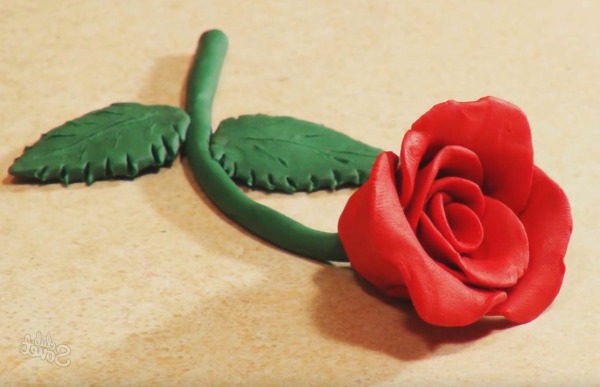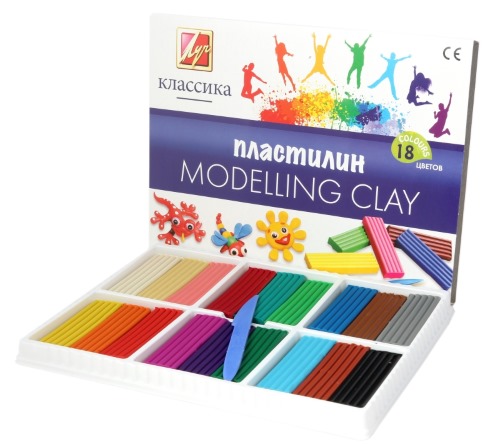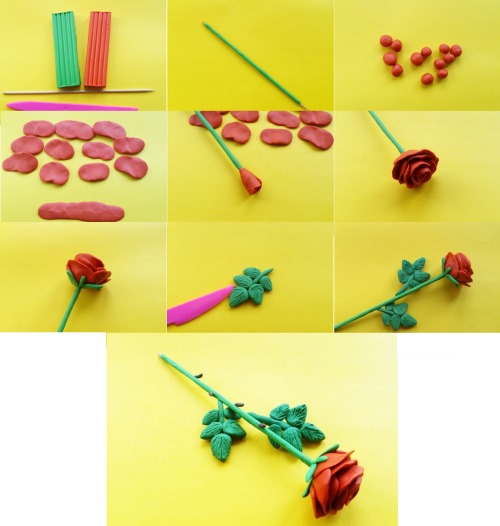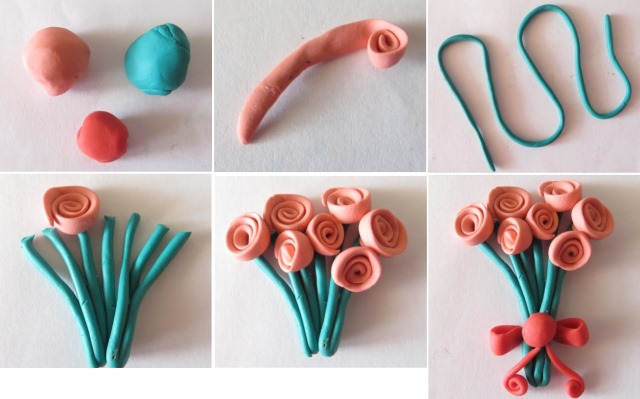Plasticine is a universal material for working with children. With its help, you can not only implement creative ideas, but also develop finger motor skills, which in the future will have a positive effect on mastering the technique of writing. The presented master class tells how to make a volumetric rose and other flowers using soft and hard plasticine.
In addition to the advantages described above, working with plasticine:
- helps to navigate in space;
- allows you to study the forms in detail;
- introduces the child to the properties.
For example, if you mold a rose, the child will learn the names of the parts of the flower, remember its appearance, and learn about the varieties of flowers.
The simplest craft of a basket with flowers like roses
This is the simplest craft of multi-colored flowers in a basket. It looks very beautiful and original, it is done quickly and easily. It does not require a cardboard lining and additional accessories.
What you will need for the craft
Materials and tools:
- plasticine of any color;
- stack;
- plastic or rubber work surface;

- children's scissors;
- cotton swab or toothpick;
- pencil.
Types of plasticine

For every type of creative activity you need the “right” plasticine.
It comes in three types:
- soft;
- medium soft;
- solid.
For modeling three-dimensional figures with preschool children, medium-soft plasticine is suitable because it is not difficult to knead.
If you use a soft type of mass, the craft will not hold its shape and will eventually spread.
Some tips for choosing plasticine:
- For modeling with small children, soft plasticine is used.
- High-quality plasticine does not delaminate or separate from each other.
- Does not stick to hands and leaves no marks.
- It has a rich color.
- Non-toxic and completely safe.
- Odorless.
Step-by-step instructions for making roses on cardboard
The article discusses several options - how to make voluminous plasticine flowers yourself and on a stand or pot.
The following instructions will tell you in detail how to make roses from plasticine on cardboard:
- It is necessary to thoroughly knead the green and pink bars.
- Now you need to make small pieces and roll them into balls.
- Each ball must be flattened.

- Now you can shape them into a rose petal. If desired, the edges of the petals are slightly bent. This gives the flower a natural look.
- This action must be done with each petal.
The final stage of bud formation is the joining of petals to each other. You can make both lush buds and inflorescences that are not fully opened. - So, we got a small blossoming rose.
- Next, to complete the craft, you need to make a stem: roll a thin twig of medium length.
- Carefully stick it to the middle of the cardboard sheet.
- Then glue short branches to the sides of the stem.
- Next, you need to mold the leaves: make an oval from a piece of plasticine and give it a flattened shape.
- Then the veins are drawn using a stack or pencil.
- Next comes the decoration of the stem with leaves.
An original postcard is ready with minimal time investment.
Master class: flower in a pot in a standing position
Step by step process:
- In order for the rose to stand, you need to twist several thin wires together and make a strip of plasticine;

- Wrap the wire with plasticine. This will create the stem of the flower. Then roll a ball out of the same plasticine;
- It is necessary to install it on top and bend the stem;
- To create an inflorescence, you need to make several flat cakes and cut out petals from them;
- Some petals need to be glued on top of the ball, and the remaining 4 pieces need to be placed on top of them and connected at the ends. It should look like a lotus;
- Two petals are cut out from pieces of green plasticine, and veins are squeezed out using a stack;
- The leaves are installed on the stem;
- To give the flower a special charm, you can decorate it with beads.
- You will need a small jar filled with stones or coarse salt.
- All that remains is to install the structure in a pot and the everlasting original flower is ready.
Composition bouquet of roses
Flower modeling is one of the ways young children learn about nature. A child will learn how to make a rose from plasticine if you go through the modeling process with him in detail and step by step.
Description:
- First, you need to decide on the number and color of flowers. To create one rosebud, you need to make long and flat stripes of one color. To make leaves, you need to form flat teardrop-shaped figures.
- For easy attachment of the bouquet, you can take a small jar or lid. The choice of pot directly depends on the size of the bouquet. In this case, a lid will be used. For stability, it should be filled with plasticine of any color. On the leaves, using a stack or a pen, draw thin veins.
- Glue all the available leaves on the pot in a circle on top. This must be done carefully, otherwise the drawn veins can be erased. To create a bud, the remaining strips of bright flowers must be tightly twisted into a bundle, and the tops split. This will create a beautiful rose.
- Next, glue the buds to the middle of the pot and the center of the leaf joint. For reliability, the buds that are glued to the center of the pot can be "put on" matches or toothpicks.
By creating such crafts, thinking and cognition develop. At the same time, the child spends time with his parents. Such a bouquet does not require any care at all: it will not wither, but will delight for many years.

A bouquet of roses made of plasticine will always find a use: they can be used to complement home decor or as a keepsake gift for grandma or mom.
Useful tips
Modeling with plasticine is an activity that promotes the development of a child's brain activity. Unfortunately for parents, plasticine is a very easily soiled material. During the modeling process, not only your hands get dirty, but also all the surfaces nearby.
When working with plasticine, it is almost impossible to avoid contamination: as a rule, children do not sit still, so both clothes and furniture around them are susceptible to stains from plasticine.
Below are several effective ways to clean any surface from plasticine:
- If the plasticine has stuck to the clothes and it is not smeared on the fabric, it can be easily removed. To do this, you need to put the clothes in the freezer for a couple of hours. This way, the paraffin contained in the plasticine will freeze and come off the clothes.
- If the plasticine is smeared on the fabric, the first method of cleaning the clothes will not help here. An iron will fix this situation. It is necessary to put thin paper, for example, toilet paper or a regular dry napkin, on both sides of the clothes. Then warm up the iron a little and iron the thing from the inside.
- It also happens that, in addition to the table and clothes, children stain carpets with plasticine. It is much more difficult to remove it from carpet surfaces than from clothes or furniture. Despite this, it is possible to remove the remains of creative activity. Pieces of ice wrapped in a plastic bag should be placed on the stain. As soon as the plasticine freezes, it can be easily removed.
- If the plasticine has left greasy stains, you can get rid of them with ammonia, gasoline or acetone.
Children like to work with plasticine: knead the soft mass, make figures, crafts. As soon as the child is interested in it, it is important to immediately show what plasticine is capable of. The first crafts should be done together with the child, for example, with the help of this article, create a rose.
Finally, a couple more video tutorials on making flowers in the form of roses.
Video about modeling from plasticine
Video instructions on how to make a rose from plasticine:
Author: Zasimova Margarita. Article formatting:Natalie Podolskaya
